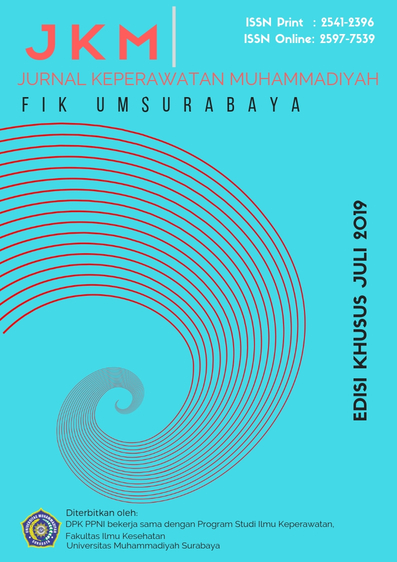Effectiveness of Exercise Therapy on the Muscle Strength, Ankle Joint Mobility and Gait Speed of Patient Diabetes Mellitus: Literature Review
DOI:
https://doi.org/10.30651/jkm.v4i2.1859Keywords:
diabetes mellitus, exercise, muscle strength, joint mobility, gait speedAbstract
Introduction: Lower extremity ulcers represent a serious and costly complication of diabetes mellitus. Many factors contribute to the development of diabetic foot, such as limited joint mobility of the ankle and foot level, impaired muscular performance and reduced gait speed. Several studies discuss the effects of planned and structured exercise or physical movements on leg muscle strength and ankle joint mobility.
Aim: This literature study aims to analyse the effect of an experimental protocol of exercise therapy on joint mobility, muscular strength and gait speed in a group of diabetic subjects.
Method: This study explores quantitative published in the electronic databases: PubMed, Science Direct, and Proquest. Using a search strategy, we identified 131 potentially relevant articles. Fourteen studies were included in the final analysis.
Result: This study obtained 14 journals that consist of RCT, quasi-experimental study, and cross-sectional. This literature study showed that  significant post-intervention improvements in limited joint mobility of the ankle and foot level, impaired muscular performance and reduced gait speed for participants who received exercise therapy compared to the control groups.
Conclusions: These results indicate that program of exercise therapy significantly improves joint mobility, muscular strength and walking speed in diabetic patients and community nurses can apply that to improve community health status.
 Â
References
Abate, M., Schiavone, C., Pelotti, P., & Salini, V. (2011). Limited joint mobility (LJM) in elderly subjects with type II diabetes mellitus. Archives of Gerontology and Geriatrics, 53(2), 135–140. https://doi.org/10.1016/j.archger.2010.09.011
Abate, M., Schiavone, C., Salini, V., & Andia, I. (2013). Management of limited joint mobility in diabetic patients. Diabetes, Metabolic Syndrome and Obesity: Targets and Therapy, 6, 197–207.
ADA. (2018). American Diabetes Association Standards of Medical Care in Diabetes-2018. Diabetes Care, 41(January). https://doi.org/https://doi.org/10.2337/dc18-Sint01
Bweir, S., & Pt, M. P. H. (2014). RELATIONSHIP BETWEEN GAIT DEVIATIONS AND RISK OF FALLS IN PATIENTS WITH TYPE 2 DIABETES. European Scientific Journal, 10(15), 132–139.
Camargo, M. R., Barela, A., Nozabieli, J. L., Mantovani, A. M., Martinelli, A. R., & Fregonesi, C. E. P. T. (2015). Diabetes & Metabolic Syndrome : Clinical Research & Reviews Balance and ankle muscle strength predict spatiotemporal gait parameters in individuals with diabetic peripheral neuropathy. Elsevier, 2–7. https://doi.org/10.1016/j.dsx.2015.02.004
Cerrahoglu, L., Koşan, U., Sirin, T. C., & Ulusoy, A. (2016). Range of Motion and Plantar Pressure Evaluation for the Effects of Self-Care Foot Exercises on Diabetic Patients with and Without Neuropathy. Journal of the American Podiatric Medical Association, 106(3), 189–200. https://doi.org/10.7547/14-095
Colberg, S. R., Sigal, R. J., Yardley, J. E., Riddell, M. C., Dunstan, D. W., Dempsey, P. C., … Tate, D. F. (2016). Physical Activity / Exercise and Diabetes : A Position Statement of the American Diabetes Association. Diabetes Care, 39(November), 2065–2079. https://doi.org/10.2337/dc16-1728
Dixit, S., Maiya, A. G., & Shastry, B. A. (2014). Effect of aerobic exercise on peripheral nerve functions of population with diabetic peripheral neuropathy in type 2 diabetes: A single blind, parallel group randomized controlled trial. Journal of Diabetes and Its Complications, 28(3), 332–339. https://doi.org/10.1016/j.jdiacomp.2013.12.006
Francia, P., Anichini, R., De Bellis, A., Seghieri, G., Lazzeri, R., Paternostro, F., & Gulisano, M. (2015). Diabetic foot prevention: the role of exercise therapy in the treatment of limited joint mobility, muscle weakness and reduced gait speed. Italian Journal Of Anatomy and Embriology, 120(1), 21–32. https://doi.org/10.13128/IJAE-16470
Francia, P., Gulisano, M., Anichini, R., & Seghieri, G. (2014). Diabetic foot and exercise therapy: step by step the role of rigid posture and biomechanics treatment. Current Diabetes Reviews, 10(2), 86–99. https://doi.org/10.2174/1573399810666140507112536
Francia, P., Seghieri, G., Gulisano, M., De Bellis, A., Toni, S., Tedeschi, A., & Anichini, R. (2015). The role of joint mobility in evaluating and monitoring the risk of diabetic foot ulcer. Diabetes Research and Clinical Practice, 108(3), 398–404. https://doi.org/10.1016/j.diabres.2015.04.001
Gerrits, E. G., Landman, G. W., Rosien, L. N., & Bilo, H. J. (2015). Limited joint mobility syndrome in diabetes mellitus: A minireview. World Journal of Diabetes, 6(9), 1108–1112. https://doi.org/10.4239/wjd.v6.i9.1108
Ijzerman, T. H., Schaper, N. C., Melai, T., Meijer, K., Willems, P. J. B., & Savelberg, H. H. C. M. (2011). Lower extremity muscle strength is reduced nn people with type 2 diazxcvbnmmmmmmmmmm,...../betes, with and without polyneuropathy, and is associated with impaired mobility and reduced quality of life. Diabetes Research and Clinical Practice, 95(3), 345–351. https://doi.org/10.1016/j.diabres.2011.10.026
Ndraha, S. (2014). Diabetes Melitus Tipe 2 Dan Tatalaksana Terkini. Medicinus, 27(2), 9–16.
Otterman, N. M., van Schie, C. H. M., van der Schaaf, M., van Bon, A. C., Busch-Westbroek, T. E., & Nollet, F. (2011). An exercise programme for patients with diabetic complications: a study on feasibility and preliminary effectiveness. Diabetic Medicine, 28(2), 212–217. https://doi.org/10.1111/j.1464-5491.2010.03128.x
Petrovic, M., Deschamps, K., Verschueren, S. M., Bowling, F. L., Maganaris, C. N., Boulton, A. J. M., & Reeves, N. D. (2017). Altered leverage around the ankle in people with diabetes: A natural strategy to modify the muscular contribution during walking? Gait and Posture, 57(May), 85–90. https://doi.org/10.1016/j.gaitpost.2017.05.016
Sartor, C. D., Watari, R., Pássaro, A. C., Picon, A. P., Hasue, R. H., & Sacco, I. C. (2012). Effects of a combined strengthening, stretching and functional training program versus usual-care on gait biomechanics and foot function for diabetic neuropathy: a randomized controlled trial. BMC Musculoskeletal Disorders, 13(1), 36. https://doi.org/10.1186/1471-2474-13-36
Suseelal, T., John, K. R., Brown, A., Judie, A., Christopher Amalraj, V., T., S., … Christopher Amalraj, V. (2016). A study to assess the effectiveness of home based aerobic training, muscle strengthening and stretching exercise on self management among individuals with diabetes mellitus (DM) at selected villages in Kancheepuram district, Tamil Nadu. International Journal of Pharmaceutical and Clinical Research, 8(2), 133–136. Retrieved from http://onlinelibrary.wiley.com/o/cochrane/clcentral/articles/044/CN-01142044/frame.html%5Cnhttp://impactfactor.org/PDF/IJPCR/8/IJPCR,Vol8,Issue2,Article3.pdf%5Cnhttp://ovidsp.ovid.com/ovidweb.cgi?T=JS&PAGE=reference&D=emed13&NEWS=N&AN=20160235244
Downloads
Published
Issue
Section
License
- Penulis tetap memegang hak atas karyanya dan memberikan hak publikasi pertama kepada jurnal ini yang secara simultan karya tersebut dilisensikan di bawah:Â Creative Commons Attribution-ShareAlike 4.0 International (CC BY-SA 4.0)













